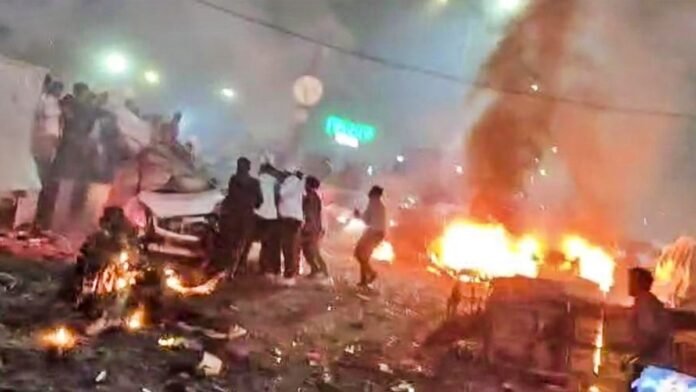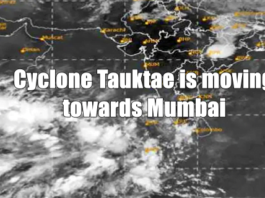
Key Points
- High-intensity blast in Eco van near Red Fort Metro Station Gate No. 1 occurred around 7:00 PM on November 9, 2025
- Casualty reports vary: NDTV sources report 5 feared dead and 11 injured; other sources confirm 1 death with several injured
- Three to four vehicles engulfed in flames following the powerful explosion
- NSG commandos and NIA teams deployed to blast site amid terrorism concerns
- High alert sounded across Delhi; Mumbai police ordered increased patrolling and security checks
- Forensic samples collected from site; cause of explosion under investigation
- Delhi Police Special Cell investigating whether blast was terrorist attack or accidental
- Alert comes one day after massive terror module busted with 2,900 kg of bomb-making materials
New Delhi: A powerful, high-intensity explosion tore through an Eco van parked near Gate No. 1 of the Lal Qila (Red Fort) Metro Station in Delhi’s historic Old Delhi area on Monday evening, creating scenes of devastation and panic in one of the capital’s most iconic locations. The blast, which occurred around 7:00 PM, was described by Delhi Police sources as “very powerful,” with such force that it caused streetlights in the vicinity to go off momentarily.
According to preliminary information from multiple sources, the explosion has resulted in significant casualties, though exact figures remain fluid as investigations continue. NDTV, citing sources within the Delhi Police, reported that five people are feared dead and 11 others injured in the incident. However, other news outlets, including India Today and Times of India, have confirmed at least one death with several others injured, suggesting that casualty figures are still being verified as victims are identified and treated.
The intensity of the detonation was such that three to four vehicles parked in the immediate vicinity of the Eco van caught fire and sustained extensive damage. Eyewitnesses described scenes of chaos as flames engulfed multiple vehicles, thick black smoke billowed into the evening sky, and panicked crowds fled the area around the metro station.
Elite Security Forces Deployed
In a development that has intensified concerns about the nature of the blast, the National Security Guard (NSG), India’s primary counter-terrorism and counter-hijacking force, and the National Investigation Agency (NIA), the country’s premier counter-terrorism law enforcement agency, have both been deployed to the blast site. The involvement of these elite units typically indicates that authorities are treating the incident as a potential security threat of national significance rather than a routine accident.
NSG commandos, often referred to as “Black Cat commandos,” are conducting thorough search operations at and around the explosion site to ensure no secondary devices are present and to secure the area for detailed forensic examination. The NIA’s deployment suggests that investigators are actively exploring the possibility of a coordinated terrorist attack.
Officials stated that the deployment of these specialized teams is part of precautionary measures to prevent any further incidents and ensure public safety in what is considered one of Delhi’s most sensitive and symbolically important areas. The Red Fort, a UNESCO World Heritage Site and the venue for India’s Independence Day celebrations, holds immense national significance, making any security incident in its vicinity a matter of grave concern.
Forensic experts have collected samples from the blast site for detailed laboratory analysis to determine the nature of the explosive materials involved, if any, and to establish whether the explosion resulted from deliberate action or an accidental cause such as a CNG cylinder leak or electrical malfunction.
Terrorism Angle Under Investigation
Delhi Police sources have confirmed that the blast is being investigated as a potential terrorist attack, though this has not yet been officially confirmed. “The possibility of a terrorist attack cannot be ruled out at this stage,” a senior police official told reporters, emphasizing that all angles are being thoroughly examined.
The heightened concern about terrorism stems from several factors. First, the location of the blast near the Red Fort one of India’s most iconic national monuments, makes it a symbolically significant target. Second, the timing and nature of the explosion raise questions about whether it was accidental or deliberately planned. Third, and perhaps most significantly, this incident comes just one day after Delhi Police busted a massive terror module and seized nearly 2,900 kilograms of bomb-making materials.
According to India Today, the discovery of such a large cache of explosives in the national capital region immediately preceding the Red Fort blast has led investigators to explore potential connections between the two incidents. The proximity in timing has heightened suspicions that the explosion may be linked to active terrorist networks operating in or around Delhi.
Delhi Police Special Cell teams, which specialize in counter-terrorism and intelligence operations, are conducting parallel investigations into both the bomb-making material seizure and the Red Fort explosion to determine if there are any operational links between the incidents.
High Alert Across Delhi and Mumbai
In response to the explosion, a high alert has been sounded across the entire National Capital Territory of Delhi, with security forces placed on heightened vigilance at all sensitive installations, public transport hubs, government buildings, crowded markets, and religious sites. The alert affects key public areas across the capital, with enhanced security protocols implemented immediately following the blast.
The security alert has also extended beyond Delhi to Mumbai, India’s financial capital and most populous city. Mumbai Police have been ordered to take precautionary measures, including increased patrolling, enhanced security checks at vital locations, railway stations, airports, and other crowded public spaces. The decision to place Mumbai on alert indicates that security agencies are concerned about the possibility of coordinated attacks across multiple Indian cities.
Authorities stated that the multi-city alert is part of a broader strategy to prevent any potential follow-up incidents and to demonstrate a robust security posture that could deter further attacks. The heightened security measures affect transport hubs in both cities, with travelers likely to experience additional screening and delays as security personnel conduct thorough checks.
Emergency Response and Fire Operations
The Delhi Fire Services received the first emergency call about the explosion around 7:00 PM on Monday evening. “The call was about an explosion in a car near Gate No. 1 of Red Fort Metro Station, following which three to four vehicles caught fire,” a fire department official explained.
Seven fire tenders were immediately rushed to the scene to combat the blaze that had erupted following the explosion. Firefighters worked swiftly to contain the flames before they could spread to the nearby metro station entrance, commercial establishments, or residential structures in the densely packed Old Delhi neighborhood.
Officials on the ground reported that several vehicles were engulfed in flames immediately after the blast, creating a challenging firefighting scenario in the congested area. However, firefighting personnel managed to bring the situation under control relatively quickly, preventing what could have been a far more catastrophic fire in the crowded Chandni Chowk area.
The injured victims were rushed to nearby hospitals, with multiple casualties brought to Lok Nayak Jai Prakash (LNJP) Hospital for emergency treatment. Medical teams have been working to stabilize the injured, though authorities have not yet released detailed information about the nature and severity of injuries sustained in the blast.
Area Cordoned Off, Forensic Investigation Underway
The Delhi Police have established extensive cordons around the Red Fort Metro Station area, sealing off a wide perimeter around Gate No. 1 where the explosion occurred. The security cordon has disrupted normal traffic flow and pedestrian movement in the busy Chandni Chowk area, though authorities have emphasized that public safety takes precedence over convenience.
Forensic experts from multiple agencies are conducting a meticulous examination of the blast site, documenting the scene, collecting physical evidence, and analyzing the pattern of damage to determine the explosion’s epicenter and likely cause. Preliminary findings indicate that the blast occurred in a parked Eco van, setting off a chain reaction that damaged nearby cars.
Investigators are examining CCTV footage from the metro station and surrounding areas to establish a timeline of events leading up to the explosion and to identify any suspicious individuals or activities in the vicinity. The vehicle’s registration details and ownership records are being traced to determine who parked the Eco van at the location and when.
The Delhi Police Special Cell, known for handling sensitive terrorism-related investigations, has taken charge of the inquiry alongside regular police units and forensic teams. This multi-agency approach reflects the seriousness with which authorities are treating the incident.
Context of Recent Security Concerns
The Red Fort explosion occurs against a backdrop of heightened security concerns in Delhi. Just three months earlier, in August 2025, a major security lapse was exposed at the Red Fort when seven Delhi Police officers were suspended after a dummy bomb went undetected during a security drill just days before Independence Day celebrations. That incident raised serious questions about security protocols at one of India’s most sensitive national monuments.
The recent bust of a terror module with 2,900 kilograms of bomb-making materials has further amplified concerns about active terrorist networks potentially operating in the national capital region. The seizure of such a large quantity of explosives represents one of the most significant counter-terrorism operations in recent months and suggests that security agencies may be dealing with a sophisticated and well-resourced threat.
The convergence of these factors, the security lapse in August, the massive explosives seizure on November 8, and now the Red Fort explosion on November 9, has created an atmosphere of heightened alert and concern about the adequacy of security measures protecting Delhi’s citizens and national monuments.
Ongoing Investigation and Unanswered Questions
As of late Monday night and early Tuesday morning, the investigation into the Red Fort explosion remains active, with multiple agencies working to establish the cause and nature of the blast. Key questions that investigators are seeking to answer include:
- Was the explosion deliberately caused or the result of an accident, such as a CNG cylinder leak?
- If deliberate, was it an act of terrorism, and if so, which group or network is responsible?
- Is there any connection between the explosion and the terror module busted with 2,900 kg of explosives just one day earlier?
- Who owned and parked the Eco van at the location, and what was its intended purpose?
- Were there any intelligence warnings or suspicious activities in the area before the blast?
The answers to these questions will likely determine not only the course of the investigation but also the broader security posture adopted by authorities in Delhi and other major Indian cities in the coming days and weeks.
The incident serves as a stark reminder of the persistent security challenges facing India’s national capital and the critical importance of maintaining robust intelligence networks, preventive security measures, and rapid response capabilities to protect citizens and national heritage sites from potential threats.



